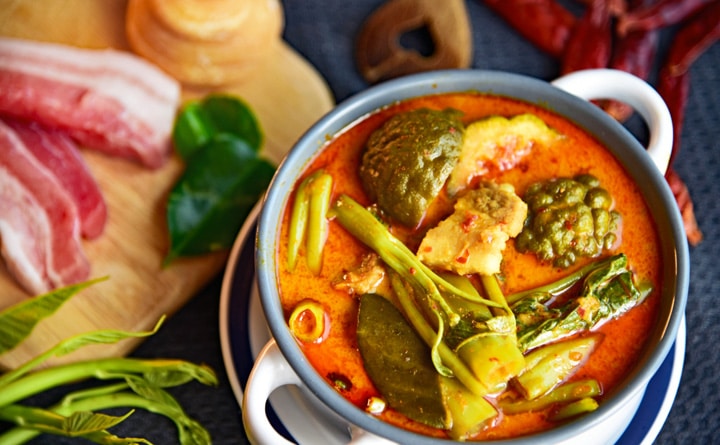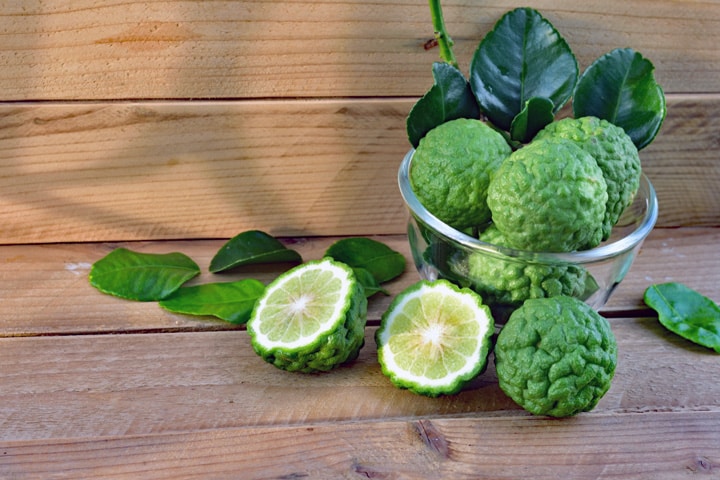
Thai cuisine has a variety of exotic dishes that will delight your taste buds. Many of these delicacies can be found in the regions. This also applies to this special curry: Kaeng thepho (แกงเทโพ) from Central Thailand. Kaeng Thepho is a signature Thai dish, known for its rich and savory flavors.
Kaeng thepho is a sweet and sour red curry from Central Thailand. It is an ancient dish and even appears in a poem by King Rama II about Siamese food. The original curry was made with oily fish, such as the belly part of the Pangasius Larnaudii (shark catfish). Now pork belly is usually used. The other main ingredient in this curry is phak bung Chin (Chinese water spinach or morning glory).
The curry looks uncomplicated, but it is one of the most difficult curries to make. Especially the spice part is a challenge. Green or red curry does not have a sour taste. Curries are mainly salty with sometimes a slightly sweet taste of coconut or added palm sugar. In the case of kaeng the-pho, there must be a harmony of three tastes: sweet, sour and salty, with the first two having to come out more and that is difficult. Even experienced Thai cooks don't want to burn their hands on it.

Bergamot fruit or Kaffir lime
Also essential to the modern version of this curry is makrut or kaffir lime. The aim is not to give the sour taste but to give its unique aroma which is an important feature of this curry. That is also a challenge, because too much or too long and the curry becomes bitter.
Because the dish is difficult to make exactly right, you won't often find it in Thai restaurants. Anyone who wants to try it can of course try it themselves.
The phonetic translation of “Kaeng Thepho” in the International Phonetic Alphabet (IPA) would be approximately as follows: [kɛːŋ tʰeː.pʰoː].
This states:
- [kɛːŋ] for “Kaeng”, with a long 'e' sound like in the English word “play” but without the y sound at the end.
- [tʰeː] for “The”, with a long 'e' sound, similar to the English word “they” but without the y sound.
- [pʰoː] for “pho”, with an aspirate 'p' sound and a long 'o' sound as in the English word “go”.
This phonetic representation helps you correctly pronounce the name of this Thai dish.
Ingredients:
- ½ teaspoon of cumin seeds
- ¼ teaspoon cardamom seeds
- 3 dried red Thai long chiles (or guajillo chiles), stemmed, seeds removed, cut into 2,5-inch pieces, soaked in warm water until softened and squeezed dry
- 1 teaspoon salt
- 1 teaspoon packed Thai shrimp paste
- 1 tablespoon wafer-thin slices of lemongrass (from the bulbous part close to the root)
- 1 4-ounce (114 g) Maesri kang kua curry paste
- 2 tablespoons finely chopped shallots
- 4 large garlic cloves, peeled
- 2 tablespoons vegetable oil
- 1 pound boneless pork belly, sliced ½ inch thick and each slice 1½ inches wide crosswise
- 1 14 ounce can coconut milk
- 2 tablespoons of fish sauce
- 3 tablespoons prepared tamarind paste (made with 340 g block of seedless tamarind pulp and 1 liter of water)
- 1 ounce of grated palm sugar
- 2 ounces (weight after cut roots and though parts of stems) water spinach (ong choy/choi or Chinese water morning glory), cut crosswise 2 1//5 inches long
- One half (sliced crosswise) of makrut lime (omit this if you can't find it. Don't use regular lime!)
Preparation:
Toast the cumin and cardamom seeds in a dry skillet over low heat until fragrant, about 2 minutes; then in a mortar. Add the chillies, salt, shrimp paste, lemongrass, curry paste, shallots and garlic one at a time; grind it in a mortar until smooth.
Toss the pasta with the vegetable oil in a large wok over medium heat until fragrant, about 1-2 minutes. Add the pork belly and stir until the pork looks cooked through on the outside. Add the coconut milk, fish sauce, tamarind and palm sugar; bring mixture to a boil, cover and simmer over medium heat for about 20-25 minutes until pork is tender with a bite.
Taste the sauce. Adjust the seasonings as needed with more fish sauce, tamarind and sugar to obtain the three flavors of sweet, sour and salty.
Stir in water spinach and lime half. Push it all down with a spatula; add more water if necessary to cover everything. Turn the heat up to high to bring the mixture back to a boil. Once it boils, immediately turn off the heat and let the residual heat cook the water spinach. Let the curry stand for 30 minutes so that the lime soaks into the sauce. Then remove and discard the lime.
Serve with rice. But if you can wait, let it sit for at least 4-5 hours (in an air conditioned kitchen) or let it cool completely, then refrigerate overnight and eat it the next day.
A slightly different variant is this:
Ingredients for Kaeng Thepho (for 4 people)
For the Curry Paste:
- 3 medium shallots, coarsely chopped
- 4 cloves garlic, coarsely chopped
- 2 stalks lemongrass, soft part only, finely chopped
- 1 piece galangal (about 2 cm), finely chopped
- 4-6 dried red chili peppers, soaked and finely chopped
- 1 teaspoon shrimp paste (optional)
For the Curry:
- 500 grams of pork belly or beef, cut into cubes
- 400 ml coconut milk
- 300 grams winter melon, peeled and cut into cubes
- 2 tablespoons of fish sauce
- 1 tablespoon palm sugar or brown sugar
- 1 handful of Thai basil leaves
- 2 kaffir lime leaves, torn
- 1-2 tablespoons of vegetable oil
- Salt to taste
Preparation
- Make the curry paste: In a mortar or food processor, blend the shallots, garlic, lemongrass, galangal, chili peppers and shrimp paste into a smooth paste.
- Preparing meat: Heat the oil in a large pan or wok over medium heat. Add the meat and fry until brown on all sides. Remove the meat from the pan and set it aside.
- Baking curry paste: In the same pan, add some additional oil if necessary, and fry the curry paste until fragrant, about 2-3 minutes.
- Add coconut milk: Add the coconut milk to the pan and bring to the boil.
- Add meat and vegetables: Put the fried meat back in the pan together with the winter melon. Simmer gently for about 20-30 minutes, or until the meat is tender and the winter melon is tender but still firm.
- Flavor: Add fish sauce, palm sugar, kaffir lime leaves and salt to taste. Let everything simmer for a few more minutes.
- Add basil: Turn off the heat and stir in the Thai basil leaves.
- To serve: Serve the Kaeng Thepho hot with steamed rice.
Enjoy this authentic Thai dish, which offers a perfect balance between rich, savory flavors and the freshness of herbs and vegetables.

